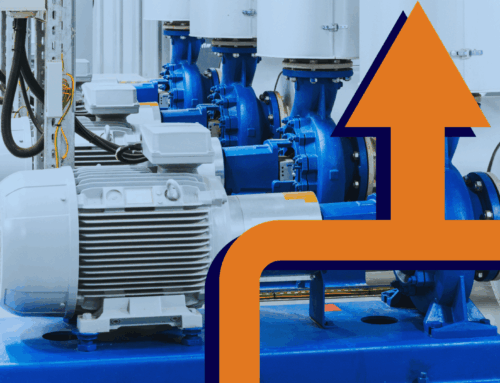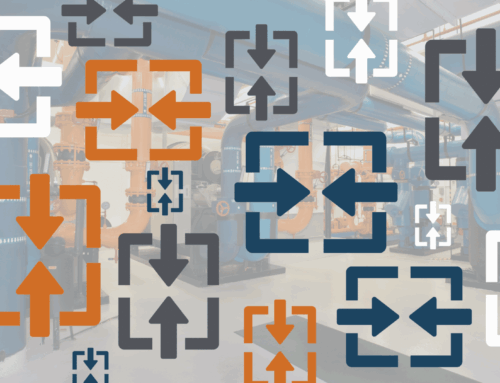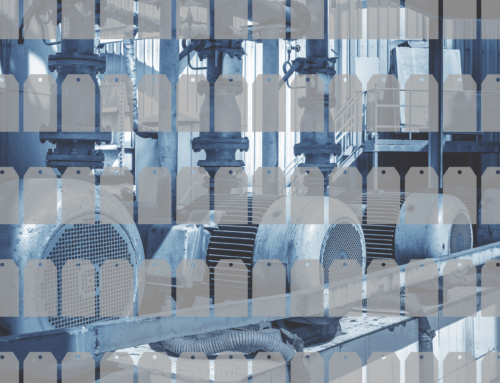How can you boost productivity in your organization? Industrial organizations dedicate significant resources to designing, planning, and implementing equipment efficiency and productivity efforts. These efforts help to improve both the quantity (productivity focus) and quality (efficiency focus) of production from energy to water to goods.
This goal of increasing productivity and efficiency looks different from the past due to the Fourth Industrial Revolution (4IR) or Industry 4.0. 4IR is a shift where cutting-edge technologies blur the physical and digital worlds. By fusing technology throughout the entire process and industrial members’ day-to-day, industrial organizations can boost productivity organization-wide or at the individual level.
What can you, your team, and your company members do to increase industrial productivity during the 4IR? HanAra has got you covered. We’re here to help you boost productivity with these helpful tips.
Connecting Technology to People: The Fourth Industrial Revolution
Beginning in the 2010s, the 4IR represents a shift in how we approach industrial processes, innovation, and problem-solving. Discrete and process organizations are at the forefront of the 4IR, where organizations and members harness the power of transformative technology to create solutions that redefine what is achievable in design, production, and optimization. By embracing digital transformation, organizations can integrate technology into work and daily lives, making processes more efficient, sustainable, and interconnected.
Integration of Digital-Physical Systems
At the 4IR’s core is the integration of digital-physical systems. These systems merge the digital and physical worlds, connecting sensors and networks with physical processes. Integrating these elements with people allows real-time data exchange and decision-making, enhancing efficiency and productivity across various industries.
Increased Data through the Industrial Internet of Things (IIoT)
The creation and expansion of the Industrial Internet of Things (IIoT) plays a pivotal role in 4IR. Industries can gather vast amounts of data in real-time with interconnected devices and sensors embedded in equipment. This connectivity facilitates smart manufacturing, predictive maintenance, and data-driven decision-making, enabling improved levels of productivity and efficiency.
Using Big Data Analytics, Artificial Intelligence, and Machine Learning
The amount of data created by interconnected devices and systems necessitates advanced analytics capabilities. Big data analytics, AI, and machine learning allow industries to gain actionable insights from an ocean of data, enabling informed decision-making and strategic planning. It empowers engineers and decision-makers to identify trends, optimize processes, and uncover opportunities for innovation.
Boosting Industrial Productivity at Your Organization
Centralize Data Insights and Management for All Members
Incorporating big data into industrial processes empowers engineers to make informed decisions from real-time insights. Whether it’s optimizing supply chain management, predicting equipment failures, or improving energy efficiency, the ability to analyze large datasets allows for a deeper understanding of complex systems and facilitates more effective decision-making. For an organization to benefit from actionable insights, it is essential to centralize data insights and properly manage the data for use across all layers of the organization.

Enable Improved Data Access
As equipment and processes create more data 24/7, organizations ensure efficient and secure access to relevant data for improved decision-making, problem-solving, and overall operations. To improve data access:
- Define Clear Data Requirements: understand the type, quality, and resolution of data required.
- Establish Data Ownership and Governance: define policies around accuracy, security, and accessibility of data, integrations, and connections.
- Implement Role-Based Access Control (RBAC): ensure members can access required data while balancing security and control requirements.
- Leverage Centralized Data Repositories: centralize data to provide a single source of truth.
- Audit and Optimize Data Access Processes: identify bottlenecks, redundancies, or inefficiencies to ensure access to information when and where it is needed.
Streamline Reporting
Reporting is critical for industrial operations, providing a structured way to communicate insights, progress, and outcomes. Whether it’s sharing project updates, presenting findings, or monitoring key performance indicators, effective reporting is essential for informed decision-making and stakeholder communication. For optimized reporting:
- Define Clear Reporting Objectives: understand what information needs to be shared, who the audience is, and what actions or decisions the report should inform.
- Embrace Automation for Efficiency: create report templates and automate reporting to give more time for analysis and decision-making.
- Implement Regular Reporting Schedules: establish regular reporting schedules to keep stakeholders informed and engaged.
- Use Visualizations Impactful Communication: incorporate data visualizations and additional context to make reports more engaging and easier to understand
- Ensure Data Accuracy and Consistency: make sure that the data used in reports is accurate, up-to-date, and consistent.
Increase Information Sharing to Improve Collaboration
Increasing collaboration around data is crucial for maximizing its value within an organization. Collaborative efforts enable teams to leverage diverse perspectives, skills, and insights, leading to more informed decision-making and innovative solutions. You can create an environment where information is accessible based on member needs. To enhance collaboration around data:
- Invest in User-Friendly Data Analysis Tools: provide members at all layers of the organization with user-friendly tools for accessing, visualizing, and analyzing data.
- Promote Data Literacy and Training: create training programs and resources to help team members understand how to interpret, analyze, and leverage data effectively.
- Facilitate Regular Data Insight Discussions: schedule regular meetings or discussions specifically focused on data insights to review, collaborate, and improve actionable intelligence.
- Encourage Cross-Functional Teams: promote collaboration by forming cross-functional teams with members who have diverse skills and expertise.
- Emphasize Open Communication: create and support an environment where members feel safe sharing their ideas and analysis based on generated data.
For more information on improving access, reporting, and collaboration, check out our data management solution, HanPrism.
Act on Early Warnings Across the Organization
Industrial organizations create a maintenance strategy that combines reactive, preventive, and predictive maintenance. Predictive maintenance (PdM) is a data-driven strategy that analyzes operations to anticipate and prepare for potential failures. The PdM method examines collected data to identify anomalies and deviations from normal patterns, employing techniques such as failure pattern searching, vibration analysis, and oil analysis. This progressive approach enhances efficiency and minimizes downtime by addressing potential issues before they escalate.

Catch a Potential Failure
Be alerted to hidden failures with predictive analytics solutions before the failures cause an unplanned shutdown. To catch a potential failure in advance:
- Collect and Monitor Real-Time Equipment Data: ensure you have quality data and access to that quality data, including temperature, pressure, flow, and other critical sensor data.
- Implement Advanced Analytics and Algorithms: use advanced analytics and machine learning algorithms to continuously process and analyze the collected equipment data.
- Establish a Normal Baseline: verify the equipment data for valid and meaningful insights. Garbage in, garbage out applies.
- Include Condition Monitoring and Diagnostics: expand the maintenance strategy to include condition-based monitoring to have real-time and actionable insights 24/7.
- Integrate Insights into Day-to-Day: create a strategy and process to incorporate the PdM insights into operations so that members will act on the insights.
Save Time and Personnel from Unplanned Maintenance
Seeing the current condition of equipment allows you to perform maintenance on equipment that needs it, not equipment that doesn’t. To save time and resources:
- Act on Early Warnings: create a plan or take immediate action when there is an early warning. PdM is about knowing and identifying potential and hidden failures and acting on them.
- Train All Layers of the Organization: the health of the equipment is vital to all layers, even if members are not a part of engineering or O&M. Down equipment means a loss in production.
- Provide the Right Insight to the Right People: determine what teams or members need specific information. Some members may need raw data and insights, while others only need a high-level overview of the insights.
- Update the PdM Tool: when operations change significantly or new equipment comes online, update the PdM modeling data. Updates will help reduce false alarms that waste team and members’ time.
- Plan for Schedule Maintenance and Overhauls: monitor the equipment degradations in real time and determine whether immediate action is needed or can wait until planned downtime.
Reduce Unnecessary Maintenance Costs
Reduce unplanned maintenance and focus time, energy, and budget on critical equipment that needs attention immediately. To minimize equipment costs:
- Reduce Run-to-Failure: equipment has a lifespan, but that doesn’t mean there are no ways to reduce the risk of premature failure. PdM can help increase the equipment’s potential to run to its fullest lifespan.
- Lessen Emergency Orders: when you have more lead to plan and act, you also have more time to order the necessary parts and schedule the required experts. More lead time reduces the amount of emergency extra costs.
- Create a Safer Environment: by eliminating potential failures in advance, you reduce the risk of functional and catastrophic failures. And a safer and more reliable environment is also a cost-savings environment.
- Prioritize Critical Assets: by knowing what equipment is unhealthy, the subject matter experts can spend more time on the critical and costly equipment.
- Ensure Production: when assets fail unexpectedly, it can result in a loss of production and revenue. As a result, PdM can help maximize revenue and reduce costs.
For more details on how an intuitive software tool can help your organization boost productivity, check out our predictive maintenance solution, HanPHI.
Appreciate Your Members and Your Equipment
Treating members and your equipment well will result in positive outcomes. By caring about your members and equipment well, an organization has a strategic advantage for a business’s overall success and sustainability. It creates a positive cycle where satisfied employees contribute to the effective care of equipment, and well-maintained equipment, in turn, supports a positive and productive work environment.

Show Them You Care
Foster a positive environment in your company to show your members you care. If there still needs to be an emphasis on the importance of a positive company culture, instill new practices that support this. Creating a positive culture can include celebrating individual wins and instilling new processes to appreciate your team members.
Showing appreciation for your co-workers has proven to boost workplace productivity. According to Glassdoor, “…four in five (81%) employees report they’re motivated to work harder when their boss shows appreciation for their work, higher than the 38% of employees who say they’re motivated to work harder when their boss is demanding or the 37% of employees who say they’re motivated to work harder because they fear losing their job. “
Have a Collaborative Outlook
Your members are your greatest asset, so amplify their expertise, perspectives, and skills by creating a collaborative environment. Whether in-person, hybrid, or remote, organizations can increase collaboration by creating cross-department project teams, setting up brainstorming meetings amongst teams, and celebrating members who help others. The more your members feel like they are a part of a team, the more comfortable they become working in one. This cross-team communication leads members to more creative discussions and new ideas after bouncing them off to one another.
Support Your Team Members
Emphasize company culture to show how important it is to business growth. You’re not alone in your company, so make everyone feel comfortable contacting and communicating with one another. It’s important to have an environment where everyone feels comfortable speaking with other organization members. Show that you’re open to giving and receiving advice, and the feeling will spread throughout the company.
Boosting Productivity at the Individual Level
Take Care of Yourself
Whether you’ve been in the industry for one or 30 years, there is always room for growth and improvement. Encouraging and supporting self-care is both a compassionate and strategic approach, as it can significantly improve productivity and contribute to the organization’s overall success.

Go for a Short Break
If members don’t take a few minutes each hour or so to stand up and stretch briefly, encourage people to get up and move for a few minutes every hour. Your muscles need movement so your body doesn’t tense up, and your mind needs a short time away from working on tasks for long periods to reset and refocus. Encouraging this helps to keep members motivated throughout the day in their daily activities.
Stay Hydrated
Ensure you drink water or other healthy fluids throughout the day to avoid dehydration and fatigue. It will help keep your vitals regulated throughout the day and reduce fatigue as it flushes out toxins. It can also help relieve joint pain if you work at a desk all day. A healthy body has a positive impact on individuals’ moods. And this positivity at the individual level can help keep morale up, and everyone focused on their tasks.
Have Compassion
Keeping a positive attitude can make a world of difference in any situation in the workplace. Show your team members you care by listening and supporting them when they speak to you. And it doesn’t mean individuals always have to be happy or cheerful. Give room for both positivity and frustration. This level of emotional safety will spread throughout the organization to lift morale and lead to better collaboration and productivity. Happy members tend to result in a happy company.
According to Business.com, “…self-care helps people stay physically, mentally, and emotionally healthy, which allows them to perform at their best and sustain high productivity in the workplace.” For more details about this and how to instill helpful habits, read their article: The Importance of Self-Care for Productivity at Work.
How We Help
HanAra’s data solutions help you increase your organization’s productivity in more ways than one. HanPrism, our data management software, centralizes data insights for all organization members. HanPHI, our predictive analytics tool, gives you advanced warnings of hidden failures so you can act before reacting later. Reach out to our solution experts to find out how we help our customers break through the limitations.






